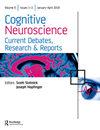语言神经计算模型中的自主语义和句法需求。
IF 2.2
4区 医学
Q3 NEUROSCIENCES
引用次数: 0
摘要
ROSE是一个罕见的语言神经计算模型,它试图将语法和解析的形式理论与基于振荡的“神经代码”结合起来,并在一定程度上成功地实现了所需的操作。ROSE成功地调和了分层和预测的句法处理,但我认为,大脑中的语言模型应该为在没有任何句法计算的情况下推导意义的可能性腾出空间,无论是分层还是预测。本文章由计算机程序翻译,如有差异,请以英文原文为准。
Autonomous semantics and syntax on-demand in neurocomputational models of language.
ROSE is a rare example of a neurocomputational model of language that attempts, and partly manages, to align a formal theory of syntax and parsing with an oscillations-based 'neural code' that could implement the required operations. ROSE successfully reconciles hierarchical and predictive syntactic processing, but I argue that models of language in the brain should make room for the possibility that meaning may also be derived in the absence of any syntactic computation, be it hierarchical or predictive.
求助全文
通过发布文献求助,成功后即可免费获取论文全文。
去求助
来源期刊

Cognitive Neuroscience
NEUROSCIENCES-
CiteScore
3.60
自引率
0.00%
发文量
27
审稿时长
>12 weeks
期刊介绍:
Cognitive Neuroscience publishes high quality discussion papers and empirical papers on any topic in the field of cognitive neuroscience including perception, attention, memory, language, action, social cognition, and executive function. The journal covers findings based on a variety of techniques such as fMRI, ERPs, MEG, TMS, and focal lesion studies. Contributions that employ or discuss multiple techniques to shed light on the spatial-temporal brain mechanisms underlying a cognitive process are encouraged.
 求助内容:
求助内容: 应助结果提醒方式:
应助结果提醒方式:


